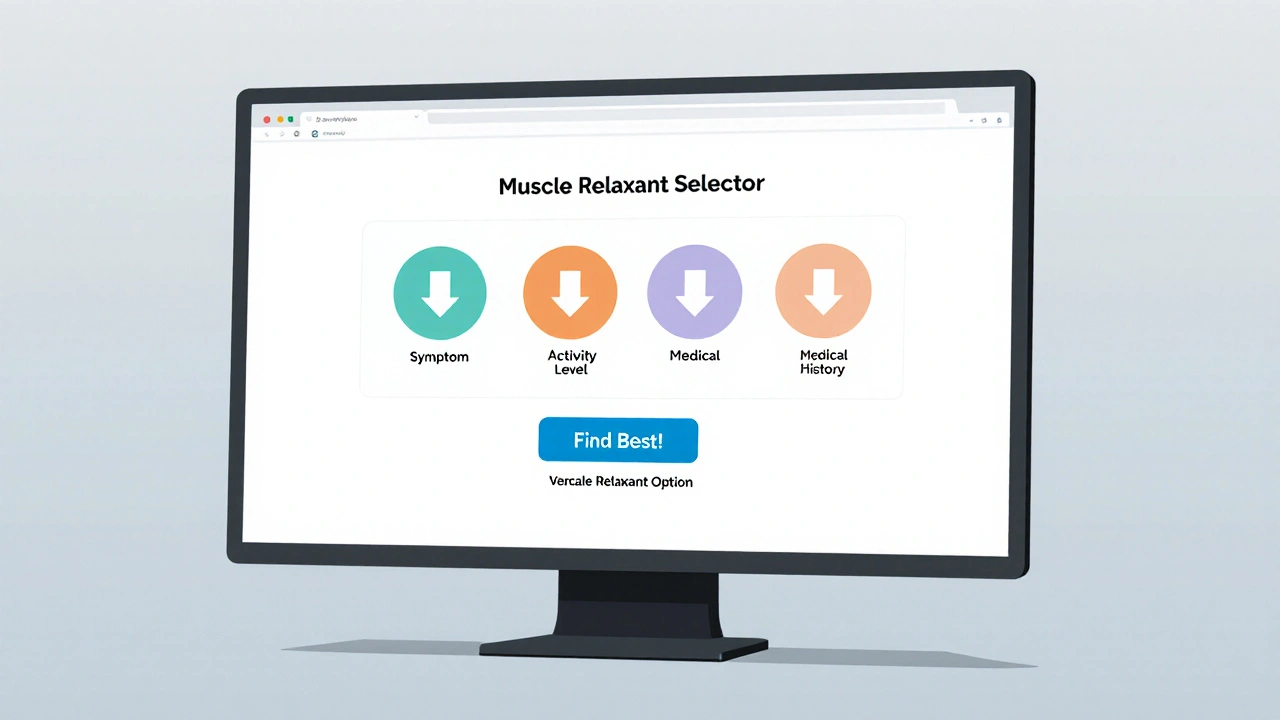Skelaxin vs Muscle Relaxant Alternatives: Which Is Right for You?

Muscle Relaxant Selector
Recommended Option:
Quick Comparison Table
| Drug | Onset | Sedation Risk | Best For | Side Effects |
|---|---|---|---|---|
| Skelaxin | 30-60 min | Low | Alertness needed | Dizziness, GI upset |
| Baclofen | 1-2 hrs | Moderate | Spasticity | Weakness, fatigue |
| Cyclobenzaprine | 45-60 min | High | Severe spasms | Dry mouth, drowsiness |
| Tizanidine | 15-30 min | Moderate-High | Rapid relief | Dry mouth, hypotension |
Skelaxin is a prescription muscle relaxant that’s often used for short‑term relief of acute musculoskeletal pain. If you’re wondering whether another drug might work better, be cheaper, or have fewer side effects, you’ve come to the right place.
- Skelaxin (Metaxalone) offers mild muscle‑relaxing effects with a low risk of sedation.
- Common alternatives include Baclofen, Cyclobenzaprine, Tizanidine, Methocarbamol, and Carisoprodol.
- Key comparison points: effectiveness, side‑effect profile, dosing convenience, and cost.
- Choosing the right option depends on your health history, activity level, and any other meds you’re taking.
What Is Skelaxin (Metaxalone)?
Metaxalone is a centrally acting muscle relaxant that reduces muscle spasm by depressing the central nervous system, though its exact mechanism isn’t fully understood. It was approved by the FDA in 1975 and is marketed under the brand name Skelaxin. The usual adult dose is 800mg taken three times daily, with a maximum of 2,400mg per day. Because it causes little drowsiness, many patients prefer it when they need to stay alert for work or school.
Common Alternatives to Skelaxin
Below are the most frequently prescribed muscle relaxants that doctors consider as substitutes. Each has its own strengths and drawbacks.
Baclofen is a GABA‑B receptor agonist that works by decreasing spinal cord reflex activity, making it especially useful for spasticity caused by multiple sclerosis or spinal cord injury. Typical dosing starts at 5mg three times daily and may be titrated up to 80mg per day.
Cyclobenzaprine is a tricyclic‑antidepressant‑derived relaxant that blocks nerve impulses (pain sensations) sent to the brain. It’s often prescribed for short‑term use (up to three weeks) at 5‑10mg three times daily.
Tizanidine is an alpha‑2 adrenergic agonist that reduces spasticity by inhibiting motor neurons. It’s taken at 2‑4mg up to three times a day, with a maximum of 36mg per day.
Methocarbamol works by depressing the central nervous system, similar to Metaxalone, but tends to be more sedating. The standard adult dose is 1,500mg four times daily for the first 48hours, then 1,000mg three times daily.
Carisoprodol is a skeletal muscle relaxant that is metabolized into meprobamate, a tranquilizer. It’s typically prescribed at 350mg three times a day for short‑term use (up to two weeks).
All these drugs aim to relieve muscle spasm, a painful involuntary contraction of a muscle or group of muscles, which is also a key term in this discussion.
How Do These Drugs Differ? A Quick Comparison
| Drug | Typical Dose | Onset of Relief | Common Side Effects | Risk of Sedation | Prescription Status |
|---|---|---|---|---|---|
| Metaxalone (Skelaxin) | 800mg 3×/day | 30‑60min | Dizziness, GI upset | Low | Prescription |
| Baclofen | 5‑20mg 3×/day (titrated) | 1‑2hrs | Weakness, fatigue | Moderate | Prescription |
| Cyclobenzaprine | 5‑10mg 3×/day (max 3wks) | 45‑60min | Dry mouth, drowsiness | High | Prescription |
| Tizanidine | 2‑4mg 3×/day (max 36mg) | 15‑30min | Dry mouth, hypotension | Moderate‑High | Prescription |
| Methocarbamol | 1,500mg 4×/day (initial), then 1,000mg 3×/day | 30‑90min | Drowsiness, nausea | High | Prescription |
| Carisoprodol | 350mg 3×/day (max 2wks) | 30‑45min | Drowsiness, dependence risk | High | Prescription |
When Is Skelaxin the Better Choice?
If you need a muscle relaxant that lets you stay awake and focused-say for a shift at the hospital or a day of driving-Skelaxin’s low sedation profile is a major advantage. It’s also relatively inexpensive in the UK NHS formulary compared with some of the more potent agents like Cyclobenzaprine.
Patients with liver impairment should use Skelaxin cautiously because it’s metabolized in the liver, but its half‑life (about 9hours) is shorter than many alternatives, reducing the risk of accumulation.

When an Alternative Might Suit You Better
Baclofen shines in neurologic spasticity rather than short‑term back pain, making it the go‑to for multiple sclerosis sufferers. Cyclobenzaprine delivers strong relief for severe muscle spasms but can knock you out, so it’s better for night‑time use or when you have a day off. Tizanidine works quickly and is useful when you need rapid onset, but it can lower blood pressure, so it’s not ideal for anyone with hypotension.
If you’re prone to drowsiness or operate heavy machinery, Methocarbamol and Carisoprodol are less attractive because they often cause pronounced sedation and, in the case of Carisoprodol, carry a dependence risk.
Cost and Accessibility in the UK
Skelaxin is usually listed under its generic name, Metaxalone, on NHS prescriptions, with a typical charge of £4.70 per prescription item for most patients. Baclofen and Tizanidine are also NHS‑covered, but access can be limited by local formularies. Cyclobenzaprine and Carisoprodol are less common in the UK and may require a private prescription, driving the price up to £20‑£30 per month.
When budgeting matters, ask your GP about generic options or whether a short course of an over‑the‑counter NSAID combined with physiotherapy could replace a prescription relaxant altogether.
Making a Decision: A Simple Checklist
- Do you need to stay alert? Choose Skelaxin or low‑dose Baclofen.
- Is rapid relief critical? Tizanidine or Cyclobenzaprine may work faster.
- Do you have liver disease? Consider Baclofen (renal excretion) over Metaxalone.
- Are you prone to dependence? Avoid Carisoprodol.
- Is cost a concern? Check NHS formulary for generic Metaxalone or Baclofen.
Frequently Asked Questions
Can I take Skelaxin with ibuprofen?
Yes, Skelaxin can be combined with ibuprofen or other NSAIDs. They work via different pathways-Skelaxin relaxes muscle tone while ibuprofen reduces inflammation-so the combo often improves pain control without extra side effects.
How long does Skelaxin stay in my system?
Metaxalone has a half‑life of about 9hours, meaning it takes roughly 2‑3 days to clear completely after the last dose, depending on liver function and age.
Is Skelaxin habit‑forming?
Unlike Carisoprodol or certain benzodiazepines, Skelaxin has a low potential for dependence, so most patients can use it for short courses without withdrawal concerns.
Can I drive after taking Skelaxin?
Because Skelaxin causes minimal drowsiness, many people can drive safely after the first dose. However, individual reactions vary-always test your response before getting behind the wheel.
What should I do if I miss a Skelaxin dose?
Take the missed tablet as soon as you remember, unless it’s almost time for the next dose. In that case, skip the missed one-don’t double‑dose.
Next Steps and Troubleshooting
If you’ve tried Skelaxin and still feel stiff, consider adding a short course of physiotherapy or stretching routines. For those who experience unwanted drowsiness, talk to your GP about switching to Baclofen or a lower dose of Metaxalone.
Always review your full medication list with your pharmacist; many muscle relaxants interact with antihistamines, antidepressants, or alcohol, increasing sedation risk. When in doubt, ask your healthcare provider to monitor liver enzymes if you stay on Metaxalone for more than a few weeks.
Finally, keep a symptom diary for at least two weeks-note the time you take the drug, pain level, any side effects, and how your daily activities are affected. This record makes it easier for your doctor to fine‑tune the treatment plan.